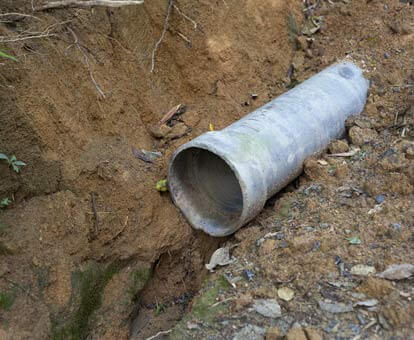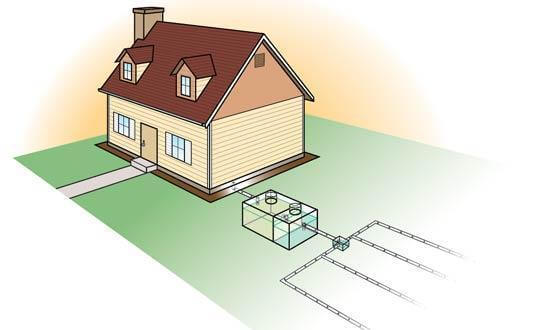Can a soakaway get blocked?
Soakaways are highly useful constructions of either gravel or plastic that allow rainwater to disperse into the soil, rather than pooling and flooding in the surrounding area.
They are an efficient and environmentally friendly way of coping with excess run-off water in both commercial and domestic environments. However, if you ever find your soakaway blocked, there are concrete steps that can be taken to remedy the situation.
What Is a Soakaway?
Traditionally, soakaways were first constructed by digging a trench or pit. The depression would then be filled in with rubble, gravel, and other permeable material.
Just like its name says, water ‘soaks’ in, and then percolates ‘away’. Any accumulating rainwater would filter through this stone-based material and become evenly distributed in a controlled manner throughout the grounds.
Nowadays, although gravel is still sometimes used, the most favoured equipment is what is known as a plastic soakaway crate. Looking a bit like a large overturned milk crate, the soakaway crate acts identically to traditional gravel.
By filtering excess surface water through its many chambers, nooks, and crannies, the plastic crate negates unwanted build-up. The rainwater is then directed outwards into the surrounding soil or further funnelled into a subterranean drainage pipe.

Signs of a Soakaway Blockage
Soakaways are generally simple, easy-to-install systems. But nothing in life is ever perfect, and problems can of course still occur.
If ever you start to notice an overflow in the outside drains and pipes on your property, these are all tell-tale signs of a blocked soakaway.
Similarly, if the earth surrounding where you think your soakaway is located is building up into dirty puddles, emanating a strong odour, or becoming squishy underfoot, you may have a blockage situation on your hands that needs immediate attention.
Another red flag is the presence of indentations in the soil.
These dips occur when the earth becomes compacted. This then causes the ground to sag as the soil compresses in on itself.
When soil becomes too densely compacted, rainwater can no longer permeate the surrounding ground, and causes a build-up of liquid in the soakaway system. The adjacent pipes will then back up and overflow into the nearby earth.
Don’t leave any of these signs unattended for long. The waterlogged ground will only become a worsening problem over time that may not be able to be addressed with a simple cleaning.
A permanently deteriorated soakaway system can wreak havoc on your property and will inevitably need to be replaced.
Causes of a Soakaway Being Blocked
Soakaways are both cleverly designed, yet deceptively simple drainage systems. Even if your soakaway was correctly installed, there are still a few culprits that can impede its effectiveness – particularly when using a plastic soakaway crate.
First of all, the nearby earth should be pre-inspected before digging and installing your soakaway. In particular, soil with high clay saturation is never suitable.
Clay is dense and not nearly as permeable as regular soil. It can cause localised flooding even when the soakaway is performing its job, as it should.
Another one of the most common blockage pain points is caused by accumulated silt and debris.
As the soakaway effectively percolates rainwater through its passages, dirt, leaves, and other small stones can become trapped inside. Over time, this build-up can impede the soakaway’s original effectiveness.
Vegetation, trees, and bushes should also not be located near or around a soakaway.
While we may love roses bushes to look at outside our garden window, plant life is always on the lookout for convenient water sources from which to drink. Their roots often grow in the direction of the nearest possible access point.
Over time, these root systems can penetrate into the soakaway crate itself and cause considerable drainage problems.
Movement from nearby motorcars and foot traffic can also cause problems with the soakaway’s effectiveness. Resulting ground movement can compress the surrounding earth, negatively impacting how the soakaway disperses rainwater naturally.

Large-scale vehicle and tractor movement can even collapse nearby pipes, spilling excess water deep into the ground beyond the working capacity of the soakaway to handle.
Last but not least, damage to a nearby septic tank can block the plastic soakaway crate.
Though it may be unpleasant to think about, large clumps of organic waste matter can (and do) leak out of poorly maintained septic tanks and find their way into a neighbouring soakaway.
If you notice a bad smell rising up from abnormally boggy ground, this may indeed be the source of your problem.
How to Treat a Blocked Soakaway?
Most of the time, soakaways behave as they were designed to, and it was simply poor installation that can be identified as the source of the problem.
If you notice your soakaway blocked, there are really only two effective remedies to choose from. Both unfortunately require excavation around the soakaway system.
The most common method to clear out a soakaway blockage is by inserting high-pressure water jets into the plastic crate itself.
The water pressure forces accumulated silt and leaves out of the crate’s small channels, thereby leaving the soakaway clear to do its job as normal. The excavated area surrounding the crate is then filled back in.

If cleaning a blocked soakaway using water and then vacuuming away the loosened silt still does not fix the problem, then unfortunately the only remaining option is to replace the crate or gravel system entirely.
Again, both of these solutions require the ground surrounding to be dug out. Unless you know what you’re doing, please leave these types of repairs to be handled by an experienced professional with the proper equipment.
Trying to dig on your own with a metal shovel can easily damage the plastic body of the soakaway crate, destroying its effectiveness.
Can Maintenance Prevent Blockage?
The answer to this question is an undeniable ‘yes’. Repeated, yearly inspections are of course the most cost-effective solution to prevent unwanted build-up and blockage to your soakaway system.
Specialists must be given visual access to the areas surrounding the system, and should be able to identify any waterlogged ground.
Similarly, silt traps must be regularly inspected and cleaned out for the optimum free flow of water within the soakaway crate. As stated previously, nearby trees and vegetation should also be regularly cut back to prevent damaging root growth.
At the end of the day, it is still recommended that a soakaway crate be fully replaced every 10-15 years. Even the most well-maintained system deteriorates over time, and a poorly functioning soakaway can cause costly damage to a beloved garden or property.
Conclusion
Soakaways are both effective and environmentally safe solutions to excess rainwater on your property. Whether you’re a small homeowner trying to keep your garden’s soil moist or a larger commercial business, soakaways can make your life easier and keep your grounds properly drained.
Of course, unforeseen problems can always occur in life, and you may find your soakaway blocked from time to time.
The most obvious red flags are boggy ground, overflowing pipes, puddles, dips in the soil, and noxious smells emanating from where you believe your soakaway is located. If you notice any of these signs then it is high time to get your system checked out.
The most common problem that affects soakaways is internal build-ups of silt, leaves, and small pebbles. These can cause the water build-up and puddles mentioned above.
The most common solution is for a professional to come and clean your soakaway out with high-pressure water jets, and then vacuum away the accumulated debris.
If this still does not solve the problem, an entirely new plastic crate will have to be installed. Both procedures will require excavation around the system.
However, just like any motor vehicle, regular maintenance can keep your soakaway working as it should. Proper cleaning can prevent any potential problems from becoming more costly further down the road.
Make sure to have a professional come to your property and perform an inspection at least once per year.
Get Your Free Quote Today
OMDI has been working for decades with the maintenance of soakaway systems, both the traditional gravel variety and plastic crates.
Whether you are concerned about minor flooding in your garden, or are a large commercial or agricultural property, our experts are on hand to advise you on all your water drainage needs.
Our team can design and install cost-effective soakaways of all sizes that will keep your property’s excess rainwater effectively managed.
If you find your soakaway blocked or suspect in any way that it is not functioning as it should, OMDI can also perform an inspection and clean it out.
Contact OMDI today for a free quote. Our knowledgeable staff are on hand and ready to assist you.
